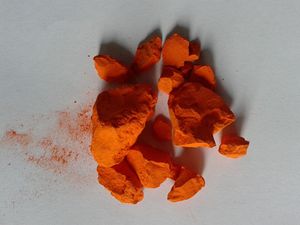Lead(II,IV) oxide
 |
This article is a stub. Please help Sciencemadness Wiki by expanding it, adding pictures, and improving existing text.
|
 Chunks of lead tetroxide.
| |
| Names | |
|---|---|
| IUPAC name
Lead(II,IV) oxide
| |
| Preferred IUPAC name
Lead tetroxide | |
| Other names
Dilead(II) lead(IV) oxide
Lead tetraoxide Minium Orange lead Red lead Triplumbic tetroxide | |
| Properties | |
| Pb3O4 | |
| Molar mass | 685.6 g/mol |
| Appearance | Orange-reddish solid |
| Density | 8.3 g/cm3 |
| Melting point | 500 °C (932 °F; 773 K) (decomposes) |
| Boiling point | Decomposes |
| Insoluble | |
| Solubility | Soluble in glacial acetic acid, hot alkali solution, hydrochloric acid Insoluble in organic solvents |
| Vapor pressure | 1.3 kPa (at 0 °C) |
| Thermochemistry | |
| Std enthalpy of
formation (ΔfH |
-725 kJ/mol |
| Hazards | |
| Safety data sheet | Sigma-Aldrich |
| Flash point | Non-flammable |
| Lethal dose or concentration (LD, LC): | |
| LD50 (Median dose)
|
630 mg/kg (rat, intraperitoneal) |
| Related compounds | |
| Related compounds
|
Lead(II) oxide Lead(IV) oxide |
| Except where otherwise noted, data are given for materials in their standard state (at 25 °C [77 °F], 100 kPa). | |
| Infobox references | |
Lead(II,IV) oxide, more commonly known as minium, red lead or triplumbic tetroxide or simply lead tetroxide, is a bright orange-reddish crystalline or amorphous oxide of lead, with the chemical formula Pb3O4.
Contents
Properties
Chemical
Lead(II,IV) oxide does not dissolve in water and does not hydrolyze. When heated to 500 °C, it decomposes to lead(II) oxide and oxygen.
- 2 Pb3O4 → 6 PbO + O2
Nitric acid dissolves the lead(II) oxide component, leaving behind the insoluble lead(IV) oxide:
- Pb3O4 + 4 HNO3 → PbO2 + 2 Pb(NO3)2 + 2 H2O
Physical
Lead(II,IV) oxide is a deep orange-reddish compound, insoluble in water. It is quite dense, 8.3 g/cm3. It is insoluble in water but soluble in hydrochloric acid.
Availability
Minium can be found as a mineral, but it's rare. Red lead was available in past as a pigment, but since most lead pigments have been phased out in the favor of lead-free ones, it is difficult to be found today. In the United States, Lead tetroxide can be bought as red lead from US Pigment.
In the EU, minium has pretty much been removed from all common uses, and thus it is not freely available anymore, though a few suppliers like Onyxmet and Laboratoriumdiscounter will still sell this compound. Restrictions on its purchase may exist in some countries though.
Preparation
Lead(II,IV) oxide is prepared by the calcination of lead(II) oxide in air, at about 450 °C:
- 6 PbO + O2 → 2 Pb3O4
A less energetic way is by mixing potassium plumbate (which can be obtained by reacting lead dioxide with potassium hydroxide) with lead(II) acetate, yielding yellow insoluble lead(II,IV) oxide monohydrate, Pb3O4·H2O, which can be turned into the anhydrous form by gentle heating:
- K2PbO3 + 2 Pb(OCOCH3)2 + 2 H2O → Pb3O4·H2O + 2 KCH3COO + 2 CH3COOH
- Pb3O4·H2O → Pb3O4 + H2O
Another method involves the reaction of oxygen with molten lead, at temperatures above 450 °C.[1]
Projects
- Lead thermite
- Lead dioxide preparation
- Lead(IV) acetate synthesis
Handling
Safety
Red lead is soluble in hydrochloric acid, such as gastric acid, and therefore it can be absorbed in the organism easily, making it extremely toxic. It should be handled with proper protection, such as gloves, face mask as well as protection goggles.
Storage
Lead(II,IV) oxide should be stored in closed bottles, with a hazardous chemical label.
Disposal
Minium should be taken to the proper disposal facilities. DO NOT POUR IT DOWN THE DRAIN!
References
- ↑ Frydlender, J.-H., Rev. Prod. Chim., vol. 50, (1947), p. 40 - 41